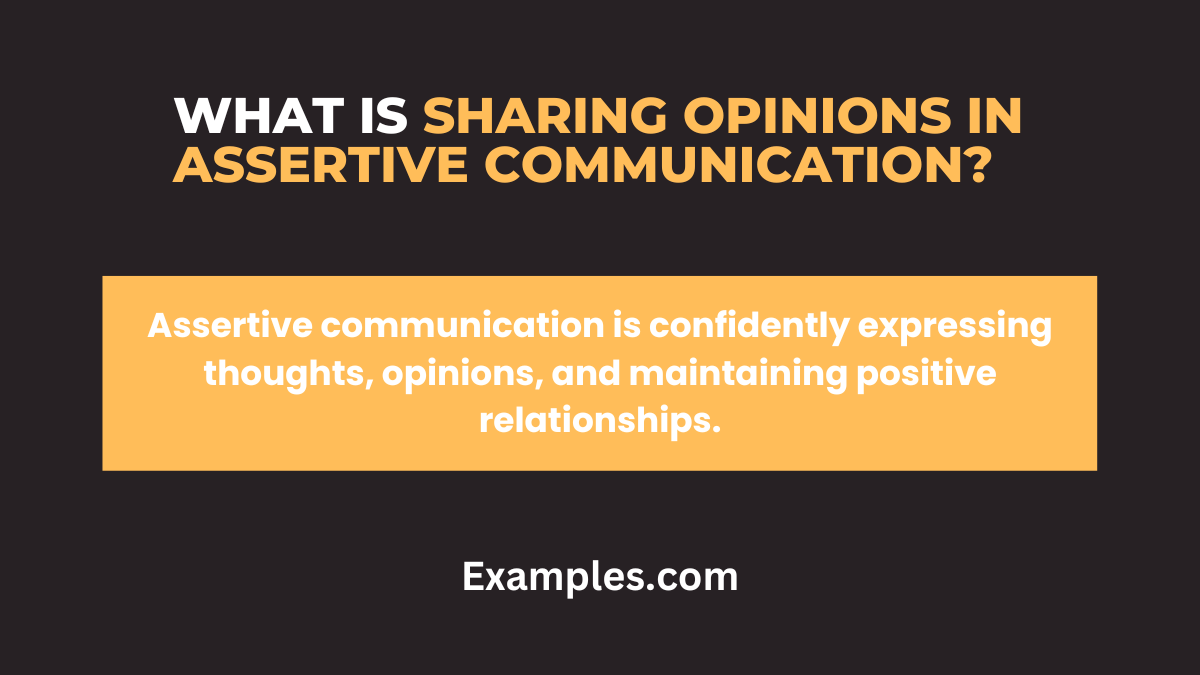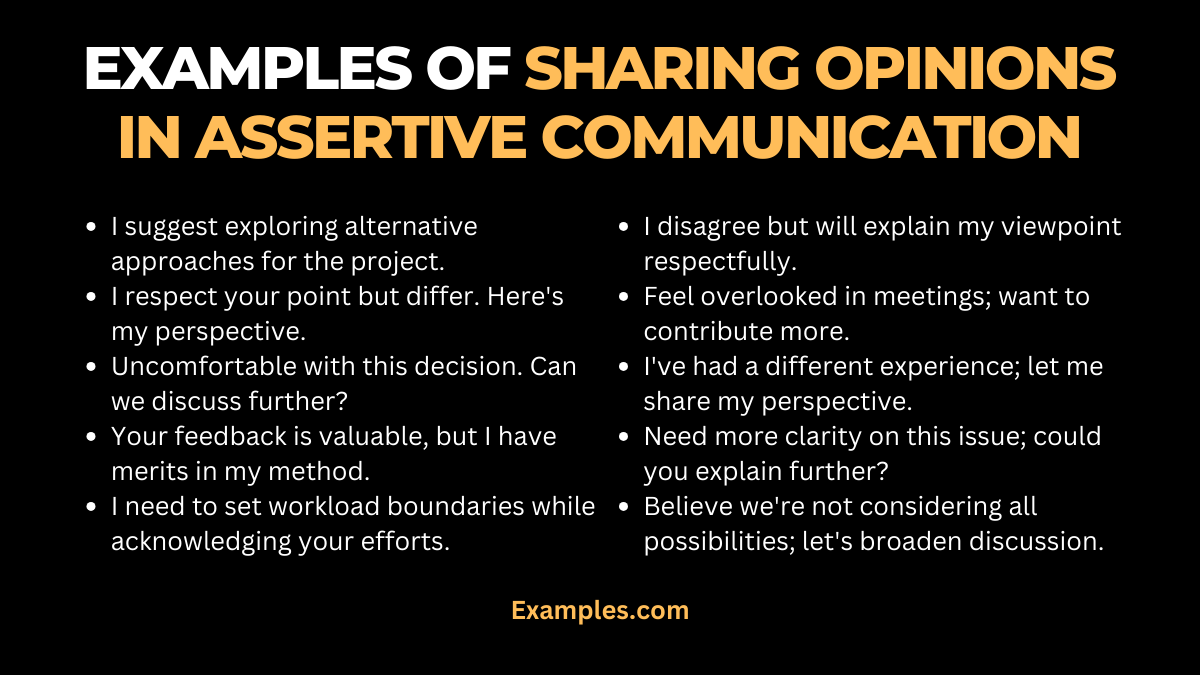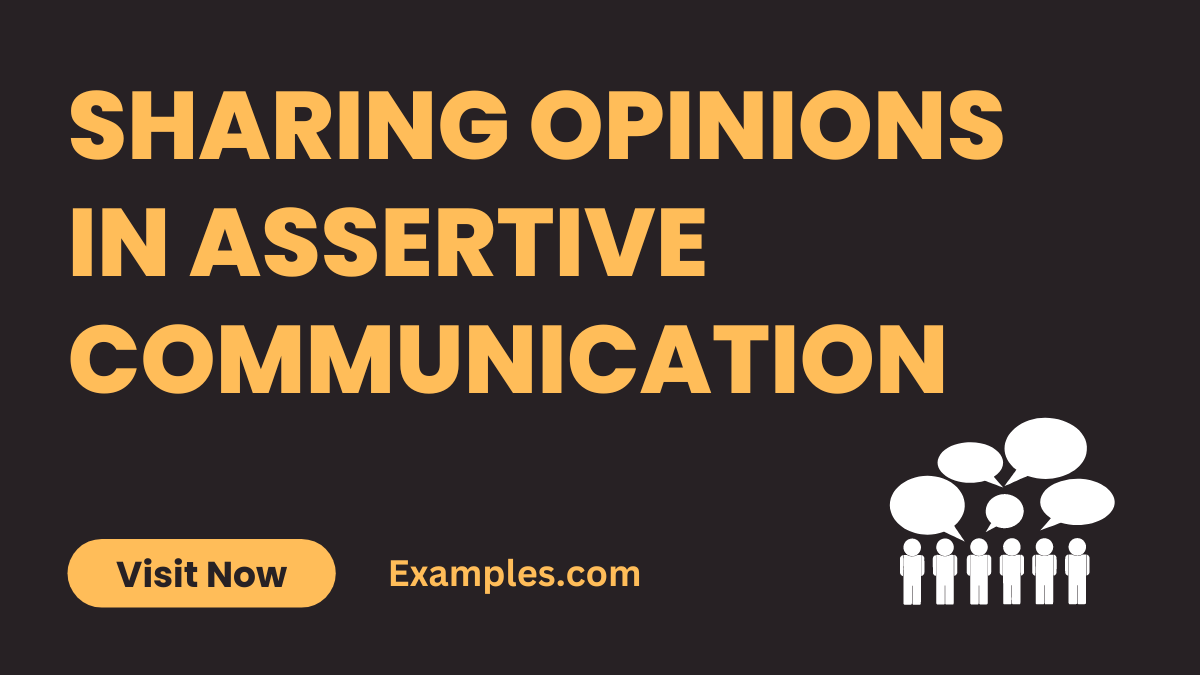19+ Sharing Opinions in Assertive Communication Examples
Navigate the art of assertively sharing opinions with our comprehensive guide. Packed with practical examples and expert tips, this resource is a treasure trove for anyone looking to enhance their communication skills. Whether in personal conversations or professional meetings, mastering assertive communication empowers you to express your thoughts clearly and respectfully. Dive into various “Communication Examples” that demonstrate the effectiveness of assertive communication, and learn how to apply these skills in your daily interactions.
What is Sharing Opinions in Assertive Communication?

Assertive communication involves expressing your thoughts and opinions clearly and confidently, while respecting others. This essential skill balances expressing oneself effectively and maintaining positive relationships.
20 Examples of Sharing Opinions in Assertive Communication

Understanding how to share opinions effectively is a vital component of Assertive Communication Skills. This guide provides 20 distinct examples demonstrating how to express your views confidently and respectfully, embodying key aspects like Empathetic Listening in Assertive Communication and Respectful Tone in Assertive Communication. Each example is accompanied by an explanation, showcasing practical sentences for assertive expression.
- “I feel that this project could benefit from a different approach. Let’s explore some alternatives.” Explains politely yet firmly the need for change, using ‘I’ statements.
- “I understand your point, but I have a different perspective. Here’s my view…” Demonstrates active listening and respectful disagreement.
- “I’m not comfortable with this decision. Can we discuss it further?” Shows emotional control while expressing discomfort.
- “Your feedback is valuable, but I believe my method also has its merits.” Balances constructive feedback with self-confidence.
- “I appreciate your efforts, but I must set some boundaries regarding my workload.” Assertively sets boundaries while acknowledging others’ efforts.
- “I disagree with that viewpoint. Let me explain why.” Direct and honest, yet maintains a respectful tone.
- “I feel overlooked in these meetings. I’d like to contribute more.” Expresses feelings of being undervalued and a desire for inclusion.
- “While I see your point, I’ve had a different experience. Here’s what happened to me…” Uses personal experience to respectfully offer a different perspective.
- “I need more clarity on this issue. Could you explain it further?” Requests information in a direct yet polite manner.
- “I believe we’re not considering all the possibilities. Let’s broaden our discussion.” Encourages open and inclusive dialogue.
- “I’m not sure I agree with this approach. Have we considered the risks?” Poses questions to gently challenge ideas.
- “I feel that my voice isn’t being heard. Can we revisit my earlier point?” Asserts the need for recognition in a discussion.
- “I think we’re moving too fast. Let’s take a moment to assess our progress.” Suggests a pause for reflection, emphasizing careful consideration.
- “I’m confident that my proposal can solve our current issue. Let me elaborate.” Presents own ideas with confidence and clarity.
- “I appreciate your perspective, but I see it differently. Here’s why.” Acknowledges another’s view before presenting an alternative.
- “I’m not comfortable with this timeline. Can we negotiate a more feasible deadline?” Expresses discomfort and proposes a solution.
- “I think there’s been a misunderstanding. Let me clarify my position.” Addresses potential miscommunications directly.
- “I value your opinion, but I must stick to my decision on this matter.” Firm yet respectful assertion of personal decision.
- “I’ve noticed a recurring issue. Can we discuss potential solutions?” Brings attention to a problem in a constructive manner.
- “I feel we’re not addressing the root cause. Let’s explore deeper.” Encourages a more comprehensive approach to problem-solving.
Benefits of Sharing Opinions in Assertive Communication
Sharing opinions in an assertive manner offers numerous benefits that contribute significantly to both personal and professional growth. The primary advantage is the enhancement of self-esteem and confidence. When individuals express their views assertively, they acknowledge their self-worth and affirm their right to voice opinions. This practice fosters a sense of empowerment and self-assurance.
Another key benefit is the improvement of communication efficiency. Assertive communication minimizes misunderstandings and ensures that messages are conveyed clearly and directly. This clarity enhances the quality of interactions and relationships, as both parties understand each other’s perspectives without ambiguity.
Moreover, assertive communication promotes respect and understanding in relationships. By sharing opinions assertively, individuals show respect for themselves and for others by valuing everyone’s viewpoints. This mutual respect strengthens relationships, whether in personal connections or professional collaborations.
Additionally, assertive communication aids in conflict resolution. By openly and respectfully expressing opinions, individuals can address issues proactively, reducing the likelihood of conflicts escalating. This approach encourages a problem-solving mindset, focusing on finding solutions rather than dwelling on problems.
Lastly, assertive communication contributes to personal integrity and authenticity. It allows individuals to be true to themselves, expressing their genuine thoughts and feelings without fear or aggression. This authenticity is vital for building trust and credibility in both personal and professional spheres.
Techniques for Sharing Opinions in Assertive Communication
Active Listening in Assertive Communication
Active listening is a cornerstone of assertive communication skills. It involves fully concentrating, understanding, responding, and then remembering what is being said. This technique ensures that the communicator not only shares their own opinions but also respects and considers the viewpoints of others. Active listening demonstrates empathy and fosters a two-way communication channel, crucial for effective assertiveness.
Clear Expression in Assertive Communication
Clear expression is essential when sharing opinions assertively. This means communicating thoughts and feelings directly and succinctly, without ambiguity. Utilizing ‘I statements’ can be particularly effective. For instance, saying “I feel that…” or “I believe…” helps in expressing personal opinions without sounding accusatory or confrontational.
Respectful Tone in Assertive Communication
Maintaining a respectful tone, even when discussing sensitive or contentious issues, is vital. This involves avoiding sarcasm, mockery, or condescension. A respectful tone fosters a safe environment for open communication and demonstrates maturity and professionalism.
Empathy in Assertive Communication
Empathy involves understanding and sharing the feelings of another. In the context of assertive communication, it means acknowledging the perspectives and emotions of others while sharing your own opinions. Demonstrating empathy can reduce defensiveness and promote a more receptive exchange of ideas.
Body Language in Assertive Communication
Non-verbal cues play a significant role in communication. Assertive body language includes maintaining eye contact, adopting an open posture, and using gestures that indicate engagement and confidence. This non-verbal assertiveness supports the verbal message and reinforces the communicator’s sincerity and confidence.
Emotional Control in Assertive Communication
Effective assertive communication requires emotional control. This involves managing emotions like anger or frustration and avoiding emotional outbursts. Keeping emotions in check ensures that the message is not overshadowed by the way it is delivered.
Constructive Feedback in Assertive Communication
When sharing opinions, offering constructive feedback can be beneficial. This means focusing on solutions and improvements rather than merely pointing out problems. Constructive feedback is solution-oriented and helps in building a positive and proactive dialogue.
In conclusion, sharing opinions assertively is a skill that can be honed through practice and mindfulness. Incorporating these techniques not only improves individual communication skills but also contributes to healthier, more productive interpersonal relationships and work environments.



